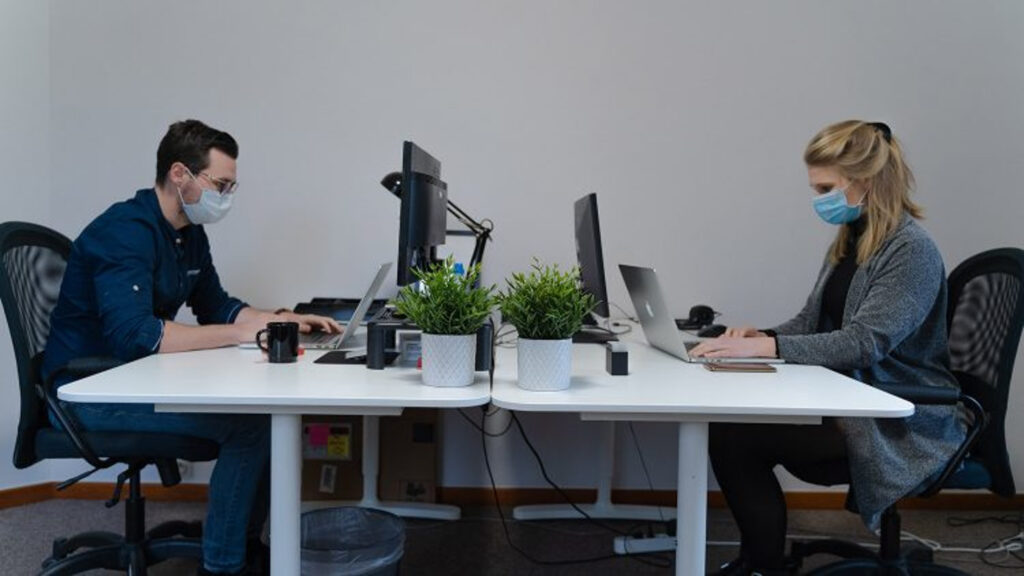With many firms re-evaluating office space and working from home policies, we asked Adam Jull of IMSCAD about the role that virtual workstations can play – and the differences between VDI, public and private cloud
The pandemic has shifted the way we all work. As the dust settles and we try to get back to some sort of normality, a hybrid work model seems to be the favoured approach of employers and employees alike. But what does this really mean for design firms who have historically invested a lot in their offices/studios to provide great spaces for client facing and for collaboration amongst staff?
The nature of hybrid work means that staff will be in the office less and split their time between the office and home – or a remote location that is not the traditional office.
As a result, less office space is required, but will this translate into firms reducing their office footprint, which could save considerable cost, or will it lead to firms changing the way they use their existing office space?
The answer is both. Those firms that can downsize now, surely will. However, those that cannot (perhaps they have a longer lease they cannot get out of) will still likely change the way they use their existing space.
In both cases, it is likely that fewer desks will be needed, staff will be hot desking, and more collaboration and meeting spaces will be required. With staff working from home for two or three days a week, firms need to ensure they invest in the right remote graphics technology solutions so everyone can work from anywhere productively.
The tech options
In the manufacturing space, the majority of designers use industryspecific applications that require a lot of resource so they can be used to their full potential. Investing in the right technology to facilitate this move to hybrid working is paramount.
VDI (Virtual Desktop Infrastructure) is a proven solution for giving design users the performance they require when working remotely. VDI technology enables you to deliver desktops via virtual machines (VMs) and the desktops are managed from a central server. There are several ways for firms to deliver these virtual desktops to their users.

On-premise or on-prem VDI is deployed on your own infrastructure. This could be one server in your office or a private data centre, where you are responsible for the infrastructure and everything associated with it. A real positive of this sort of solution is that the servers can be provisioned to suit your use case, your specific application-mix and the individual user workloads.
Private cloud or hosted VDI is when virtual desktops are outsourced. They are deployed and hosted in a hosting company’s datacentre, on bare metal servers, and the hosting company is responsible for the infrastructure.
Like the on-premise solution, firms get the same benefits of provisioning infrastructure to match their use cases, applications and workflows with the extra advantage of not having to buy or manage the hardware.
Hyperscale or Public Cloud Desktops eg. Microsoft Azure, AWS, Google Cloud. This is where a firm pays for ‘instances’ of virtual desktops.
While spinning up a new instance is easy, a VDI solution on the public cloud still requires extra underlying infrastructure and integration components to work. From the architecture and networking to the security, the customer is responsible for everything they build in the public cloud.
What are the benefits?
The benefits of these types of solutions are many – most importantly furnishing your users with the performance they require when working both in the office and at home – or anywhere else for that matter. Historically, users have been reluctant to give up their physical workstations as they have worried about not getting the same performance when using other technologies.
This was highlighted for many as they tried to work from home on hastily put together remote work solutions that did not give the performance they required when they suddenly had to vacate the office.
Your IP is obviously very important and security is another great benefit of this type of solution.
With all data being stored centrally, no data leaves the infrastructure. With applications also kept centrally on the servers, all patches, upgrades and fixes can be managed centrally as a single instance and the management of users, their access to applications and data is also centrally controlled by IT which will result in a reduction in IT management costs.
With users not relying on their physical workstations and not having to be at their desks, firms are far more resilient to any interruptions. In addition to obvious pandemics, this could be due to bad weather stopping travel or a fire at the office. With a virtual desktop solution there is a built-in business continuity capability, meaning users can remain working and therefore productive no matter what happens.
What are the real costs?
Cost is obviously a major factor in determining the solution that you will go with, and the costs associated with each of these deployment methods will vary.
When looking at an on-premise solution, there is a large CapEx (Capital Expenditure) required as the infrastructure needs to be purchased, racked and set up before you can start provisioning the desktops. Once fully functioning, the cost are minimal – yearly licence renewals and support.
With a private or hosted cloud solution, there will be an upfront fee to set up and then a monthly cost, keeping CapEx to a minimum and enabling a more manageable OpEx (Operational Expenditure) model.
When looking at a Public Cloud VDI solution there are no upfront costs – you just pay for the instances. However, you will need to add additional products and components to your virtual infrastructure, from domain controllers to VMs and each comes with an associated cost on top of the cost of each instance.
One step at a time
Not all firms move to VDI in one go. Some firms continue to utilise their physical workstations and often use the VDI solution to facilitate remote work. Often they will sweat the workstation until end of life, by which time the user is accustomed to working on a virtual desktop and the change to doing so full time is not so dramatic.
Another facet to this is those firms that are starting small, providing a VDI solution for a single team or for a specific project – in essence using this as a pilot. Some firms will actually invest in a single server either on-premise or a private cloud, specifically as a pilot project and get users from all over the firm to test. Both are sensible approaches.
As we start to come out the other side of the pandemic, and attitudes to the traditional office continue to change, firms are looking for more robust IT solutions to support flexible working
There are also firms employing a hybrid approach, as it is a big ask to migrate to the cloud in one single leap. You also need to factor in that public cloud providers might not be the most cost effective for the types of applications and workloads that design and engineering firms are using.
Closing thoughts
When the Covid-19 pandemic first hit, many manufacturing firms had to quickly adapt existing IT to allow designers and engineers to work effectively from home. Data centralisation was key, so remoting into office workstations quickly became a temporary fix for some.
Now as we start to come out the other side, and attitudes to the traditional office continue to change, firms are looking for more robust IT solutions to support flexible working. And proven technologies like VDI present a huge opportunity for those looking to fully embrace a truly hybrid future.
Learning by example VDI and private cloud
Parkhill, a US architect and engineering firm with nine offices spread across Texas, Oklahoma and New Mexico, has deployed a successful VDI solution that gives 400+ creative professionals the freedom to work anywhere, on any device using all of their applications including the Autodesk suite.
Parkhill invested in an on-premise solution, with 16 servers running 430 desktops using Citrix. In light of the pandemic, Parkhill will tell you it has gained an advantage over its peers from a mobility standpoint and an IT management perspective.
The solution has come into its own during the pandemic, with nearly all staff working from home and now working two or three days a week away from the office.
On a smaller scale is a UK-based manufacturing firm that was looking to minimise future disruption on productivity, in terms of hours and days lost with users not being able to work to their full potential when they could not access the office during the pandemic.
The firm needed a solution to enable remote work for 50+ design users and chose a private cloud solution. The solution included three servers, two of which include two GPUs, providing desktops to 20 users each and the third, one GPU providing desktops for the further 12 users.
Another example of a successful on-premise VDI solution is that of HUNT EAS, a New York-based engineering, architectural and surveying firm. Hunt had an existing Virtual desktop solution in place, but the solution had never performed, and the company was looking to upgrade from the existing four server environment providing desktops for 65 users to one providing desktops to 90+ users.
The new environment consists of five servers and provides all users great performance running AutoCAD, Autodesk Revit and other applications. It has proved invaluable over the last year through the pandemic as well as when major snowfall affected New York last winter.
This article is part of DEVELOP3D’s 2021 workstation special report. To read the other articles and reviews in this report click on the links below.
Desktop workstation buyer’s guide
Greg Corke goes back to basics with some general advice for those looking to buy a workstation for product development workflows
Intel Core vs AMD Ryzen
We explore the best CPUs for design-centric workflows from CAD to reality modelling and rendering
Scan 3XS GWP-ME A132R (AMD Ryzen 9 5000) review
This Ryzen 5000 beast from Scan excels in rendering and extreme multi-tasking
Workstation Specialists WS-184 (11th Gen Intel Core) Review
This 11th Gen Intel Core workstation is ideal for CAD centric workflows
CAD workstation round-up
The latest workstations for CAD-centric workflows
Best lightweight workstation laptops
Ultra-portable mobile workstations to take CAD and design visualisation on the road
AMD Radeon Pro W6800 GPU Review
This 32 GB beast is the first pro GPU from AMD with hardware-based ray tracing built in
AMD Radeon Pro Viewport Boost Review
Pro driver feature dramatically increases 3D performance by dynamically reducing viewport resolution
Nvidia RTX A4000/A5000 GPU’s Review
New pro ‘Ampere’ GPUs slice through real-time 3D, ray tracing and VR workflows
Autodesk graphics engine to ‘radically improve’ in Inventor
New One Graphics System (OGS) will boost viewport performance and add GPU ray tracing
Talking heads: Multicore for CAD
Is there scope for making CAD software more multithreaded, enabling it to use more cores, more efficiently – or does the sequential nature of many operations mean the hands of CAD software developers are tied? We asked the experts to find out more






